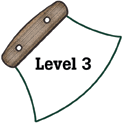
Alaska Science
Key Element A14c
A student who meets the content standard should understand that a small change in a portion of an environment may affect the entire environment (Interdependence).
 |
Alaska Science A student who meets the content standard should understand that a small change in a portion of an environment may affect the entire environment (Interdependence). |
|
Performance Standard Level 3, Ages 11–14
|
|
|
|
Sample Assessment Ideas
|
|
|
Expanded Sample Assessment Idea
|
|
Procedure Students will:
Reflection and Revision
|
Levels of Performance |
||
|
Stage 4 |
Student work is complete, and shows evidence of logical reasoning. Student report includes a thorough investigation of the animals’ food needs, eating habits and ability to adapt to new or stressful environmental conditions. | ||
|
Stage 3
|
Student work shows evidence of logical reasoning but may contain minor errors or omissions. Student report includes an investigation of the animals’ food needs, eating habits, and ability to adapt to new or stressful environmental conditions. | ||
|
Stage 2
|
Student report may include the eating habits of the animal, but may be incomplete, and contain errors of science fact and reasoning. | ||
|
Stage 1
|
Student report is incomplete, and may contain major misconceptions. | ||
Standards Cross-References
|
||
|
National Science Education Standards Behavior is one kind of response an organism can make to an internal or environmental stimulus. A behavioral response requires coordination and communication at many levels, including cells, organ systems, and whole organisms. Behavioral response is a set of actions determined in part by heredity and in part from experience. (Page 157) An organism’s behavior evolves through adaptation to its environment. How a species moves, obtains food, reproduces, and responds to danger are based in the species’ evolutionary history. (Page 157) The number of organisms an ecosystem can support depends on the resources available and abiotic factors, such as quantity of light and water, range of temperatures, and soil composition. Given adequate biotic and abiotic resources and no disease or predators, populations (including humans) increase at rapid rates. Lack of resources and other factors, such as predation and climate, limit the growth of populations in specific niches in the ecosystem. (Page 158) |
Benchmarks In all environments-freshwater, marine, forest, desert, grassland, mountain and others-organisms with similar needs may compete with one another for resources, including food, space, water, air, and shelter. In any particular environment, the growth and survival of organisms depend on the physical condition. (Page 117) Climates have sometimes changed abruptly in the past as a result of changes in the Earth’s crust, such as volcanic eruptions or impacts of huge rocks from space. Even relatively small changes in atmospheric or ocean content can have widespread effects on climate if the change lasts long enough. (Page 69) Fresh water, limited in supply, is essential for life and also for most industrial processes. Rivers, lakes, and groundwater can be depleted or polluted, becoming unavailable or unsuitable for life. (Page 69) The benefits of the Earth’s resources-such as fresh water, air, soil, and trees-can be reduced by using them wastefully or by deliberately or inadvertently destroying them. The atmosphere and the oceans have a limited capacity to absorb wastes and recycle materials naturally. Cleaning up polluted air, water, or soil or restoring depleted soil, forests, or fishing grounds can be very difficult and costly. (Page 69) |
|
Table of Contents | Return to Alaska Native Knowledge Network